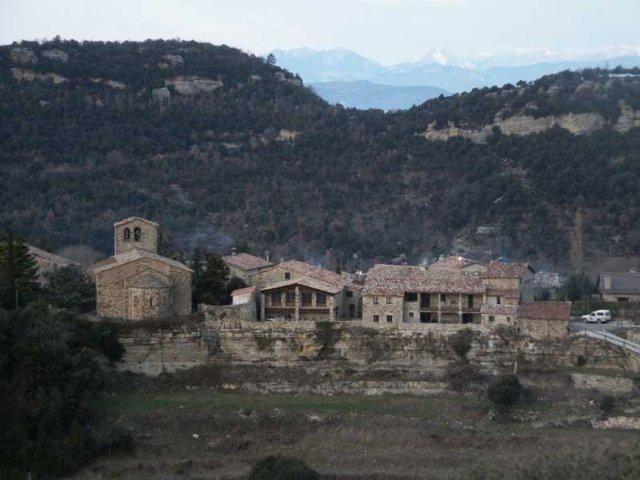| Vic - Tavertet | |
|
|
|
|
1 Day |
|
|
VIC Vic is the capital of the
comarca of Osona, in the province of Barcelona,. Vic's location, only 69
km far from Barcelona and 60 km from Girona, has made it one of the most
important towns in central Catalonia. Vic
is of ancient origin. Vic, in past times, was called Ausa by the Romans.
Iberian coins bearing this name have been found there. The Visigoths
called it Ausona. During
the 8th and 9th centuries, Vic sat in the Spanish Marches that separated
Frankish and Islamic forces. It was destroyed in 788 during a Muslim
incursion. Afterwards only one quarter was rebuilt, which was called Vicus
Ausonensis (vicus is Latin for city borough), from which the name Vic was
derived. It was repopulated by Wilfred the Hairy in 878 who gained control
over the high part of the city and gave up the lowest part to the bishop
to construct the episcopal see. From then on, the city was ruled by the
count of Barcelona and by the bishop of Vic. At
a council in Toulouges in 1027, the bishop of Vic established the first
Peace and Truce of God that helped reduce private warfare. During
the 18th century the city was the first focus of the rebellion against the
centralist policy of King Philip V of Spain. The conflict became the War
of the Spanish Succession, which resulted in Catalonia losing its freedom
as a nation. In
the early 20th century Vic had 9500 inhabitants, and in 1992 it hosted
Roller Hockey events of the Barcelona 1992 Summer Olympics. It
is disputed whether the Church of Sant Pere Ap˛stol or Sta. Maria la
Rodona [1] was the first cathedral church. For centuries the bishops
celebrated the first Christmas Mass in this church, and the third in that
of Sant Pere. The
ancient Church of S. Maria was rebuilt from the foundations by Canon
Guillem Bonfil in 1140, and consecrated forty years later by Bishop Pere
Retorta. In 1787 it was demolished to make room for the new Cathedral.
Bishop Jordi (915- 38) reconsecrated the Church of Ripoll and also
consecrated that of Sta. Maria de Manresa. The
original cathedral, which had but a single nave, thick walls, and few
windows, was replaced by that built by Bishop Oliva. As early as the
thirteenth century Bishop Raimond d'Anglesola wrote a pastoral letter
exhorting his people to contribute towards repairing the cathedral. In
1401 Bishop Diego de Heredia added a transept, and in 1585 the door of
Sant Joan was added, but the necessity of a complete reconstruction was
soon recognized, and towards the end of the eighteenth century the
building was torn down, and the corner stone of the new one was laid on 24
September, 1781. It was consecrated on 15 September, 1803. It is classic
in design, a combination of Doric and Tuscan, with a facade of white stone
enriched with a beautiful balustrade. It has three entrances,
corresponding to the three naves, and colossal statutes of its six patrons.
The interior is Corinthian. All the monuments and altars were destroyed
when the old church was demolished, except the high altar which is of
alabaster, in the Gothic style, and was given early in the fifteen century
by D. Bernat Despujol. Among the chapels that of St. Bernat Calvˇ
(1233-43), who assisted James I of Aragon in the conquest of Valencia,
deserves special mention. The two-storied Gothic cloister is exceedingly
beautiful. A handsome Gothic doorway leading to the chapter house has been
preserved. The
conciliar seminary was begun in 1635 by Gaspar Gil and was finally
finished, by command of Pope Benedict XIV, by Manuel Mu˝oz in 1748. The
modern seminary is located in the former Jesuit College. It has sent out
many famous men, among them Balmes and the poet Jacint Verdaguer, author
of "L'AtlÓntida". The episcopal palace was destroyed in the
wars of 1640 and rebuilt by degrees, being completed by Bishop Veyan. The
archaeological museum is in this building. Manresa,
where St. Ignatius Loyola wrote his Spiritual Exercises, is situated in
the Diocese of Vic. His memory is venerated in the Santa Cova, which has
been converted into a church, and a magnificent college of the Jesuits
built near it. Tavertet Tavertet
is a small town above some cliffs, 900m above sea level, in the area known
as Collsacabra in the comarca of Osona in Catalonia. Below the cliffs is
the "Sau" reservoir which dammed the waters of the river Ter in
the 1960s. Tavertet is a lovely touristy town, with many second homes and
home to Raimon Panikkar, who is an Indian/Catalan philosopher. Tavertet is
linked by a main road to L'Esquirol and the C-153 and to Rupit by a minor
road which runs north above the cliffs which also links to the C-153
closer to Rupit. |
|
